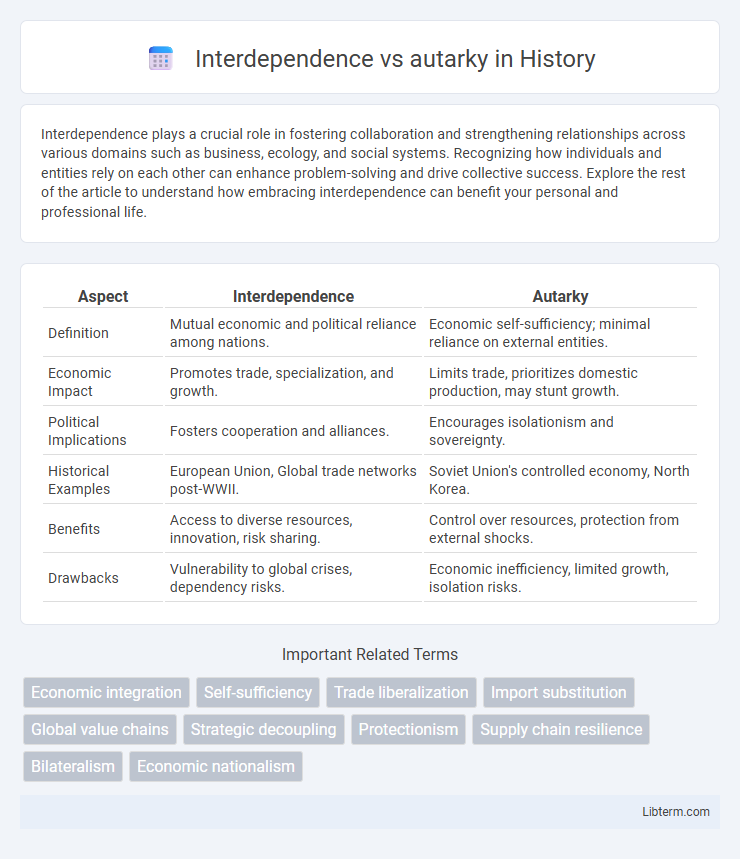Interdependence plays a crucial role in fostering collaboration and strengthening relationships across various domains such as business, ecology, and social systems. Recognizing how individuals and entities rely on each other can enhance problem-solving and drive collective success. Explore the rest of the article to understand how embracing interdependence can benefit your personal and professional life.
Table of Comparison
| Aspect | Interdependence | Autarky |
|---|---|---|
| Definition | Mutual economic and political reliance among nations. | Economic self-sufficiency; minimal reliance on external entities. |
| Economic Impact | Promotes trade, specialization, and growth. | Limits trade, prioritizes domestic production, may stunt growth. |
| Political Implications | Fosters cooperation and alliances. | Encourages isolationism and sovereignty. |
| Historical Examples | European Union, Global trade networks post-WWII. | Soviet Union's controlled economy, North Korea. |
| Benefits | Access to diverse resources, innovation, risk sharing. | Control over resources, protection from external shocks. |
| Drawbacks | Vulnerability to global crises, dependency risks. | Economic inefficiency, limited growth, isolation risks. |
Understanding Interdependence and Autarky
Interdependence in economics refers to the mutual reliance between countries for goods, services, and resources, enhancing efficiency and promoting global trade. Autarky represents a self-sufficient economic system where a country minimizes external trade to maintain independence. Understanding the balance between interdependence and autarky is crucial for assessing economic resilience, trade policies, and national security strategies.
Historical Context: Interdependence and Autarky in Global Trade
Historical context reveals that interdependence in global trade emerged notably after World War II with the establishment of institutions like the General Agreement on Tariffs and Trade (GATT) and later the World Trade Organization (WTO), promoting economic cooperation and reducing trade barriers. Autarky, by contrast, was a dominant policy in the early 20th century, especially during the Great Depression and World War I, when nations sought self-sufficiency to avoid reliance on unstable external markets. The shift from autarky to interdependence reflects the global recognition that integrated economies enhance growth, resource allocation, and technological exchange.
Key Features of Economic Interdependence
Economic interdependence features the mutual reliance of countries on one another for goods, services, technology, and capital, promoting specialization and increased efficiency through comparative advantage. It fosters international trade networks, supply chain integration, and economic growth by encouraging resource allocation aligned with global demand. Unlike autarky, which emphasizes economic self-sufficiency and limited foreign trade, interdependence enhances market access, innovation diffusion, and economic resilience through diversified partnerships.
Core Principles of Autarky
Autarky centers on economic self-sufficiency, minimizing reliance on international trade and external resources to achieve independence. Core principles include maximizing domestic production, protecting local industries through tariffs and import restrictions, and promoting internal resource utilization to sustain national growth. This approach emphasizes sovereignty and stability by insulating the economy from global market fluctuations and external shocks.
Advantages of Economic Interdependence
Economic interdependence fosters specialization, allowing countries to focus on producing goods and services where they have a comparative advantage, leading to increased efficiency and higher overall output. Access to a broader range of goods and services enhances consumer choice and drives innovation through competitive markets. Furthermore, interdependent economies tend to experience more stable growth and reduced risks, as diversified trade relationships mitigate the impact of local economic shocks.
Benefits and Challenges of Autarky
Autarky, characterized by economic self-sufficiency, reduces dependency on global markets, enhancing national security and protecting domestic industries from external shocks. However, autarky often leads to inefficiencies, higher production costs, and limited consumer choices due to the lack of comparative advantage and economies of scale. The challenges include potential resource scarcity and slower technological innovation compared to interconnected economies benefiting from specialization and trade.
Case Studies: Successes and Failures of Both Approaches
Economic interdependence fosters global trade, evidenced by the success of countries like Germany and China, which leverage comparative advantage to boost growth and innovation. Autarky, as seen in North Korea and Albania during the Cold War, often results in economic inefficiencies, limited technological progress, and reduced consumer choice. Case studies highlight that while autarky can protect domestic industries in the short term, long-term sustainability and prosperity typically require integration into global markets.
Interdependence and Autarky in the Modern Global Economy
Interdependence in the modern global economy fosters specialization and trade, enhancing efficiency and innovation by allowing countries to leverage comparative advantages. Autarky, or economic self-sufficiency, limits exposure to global markets, often resulting in higher production costs and reduced access to diverse resources and technologies. The increasing complexity of international supply chains underscores the strategic importance of interdependence for sustained economic growth and resilience.
Security, Resilience, and Self-Sufficiency: Weighing the Trade-offs
Interdependence enhances security by fostering alliances and resource-sharing but raises vulnerability to external shocks and geopolitical tensions. Autarky strengthens resilience through self-sufficiency, reducing reliance on global supply chains and minimizing exposure to international disruptions. Balancing these trade-offs requires strategic assessment of economic stability, national security priorities, and critical resource availability.
Future Trends: Striking a Balance between Interdependence and Autarky
Future trends reveal a nuanced balance between interdependence and autarky as nations seek economic resilience while maintaining global trade networks. Emerging technologies and shifting geopolitical dynamics encourage diversified supply chains and regional cooperation to mitigate risks from overdependence. Strategic investments in domestic innovation and resource development complement international partnerships, fostering sustainable growth amid global uncertainties.
Interdependence Infographic

 libterm.com
libterm.com